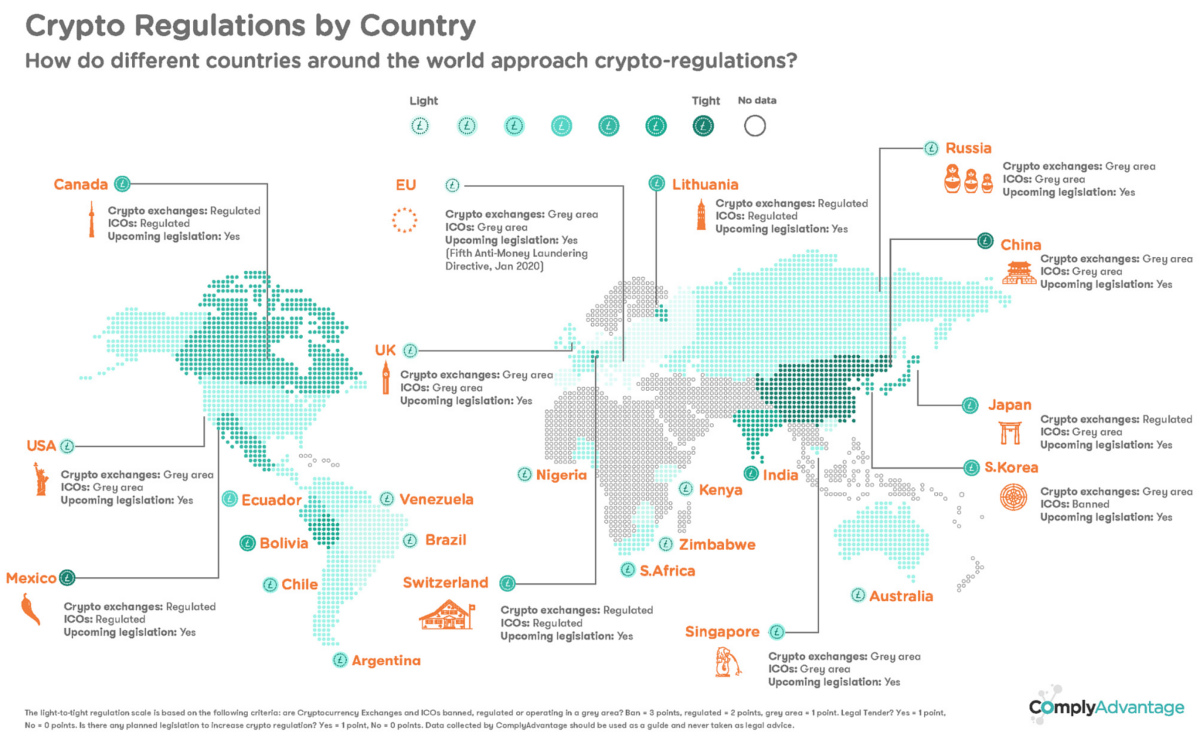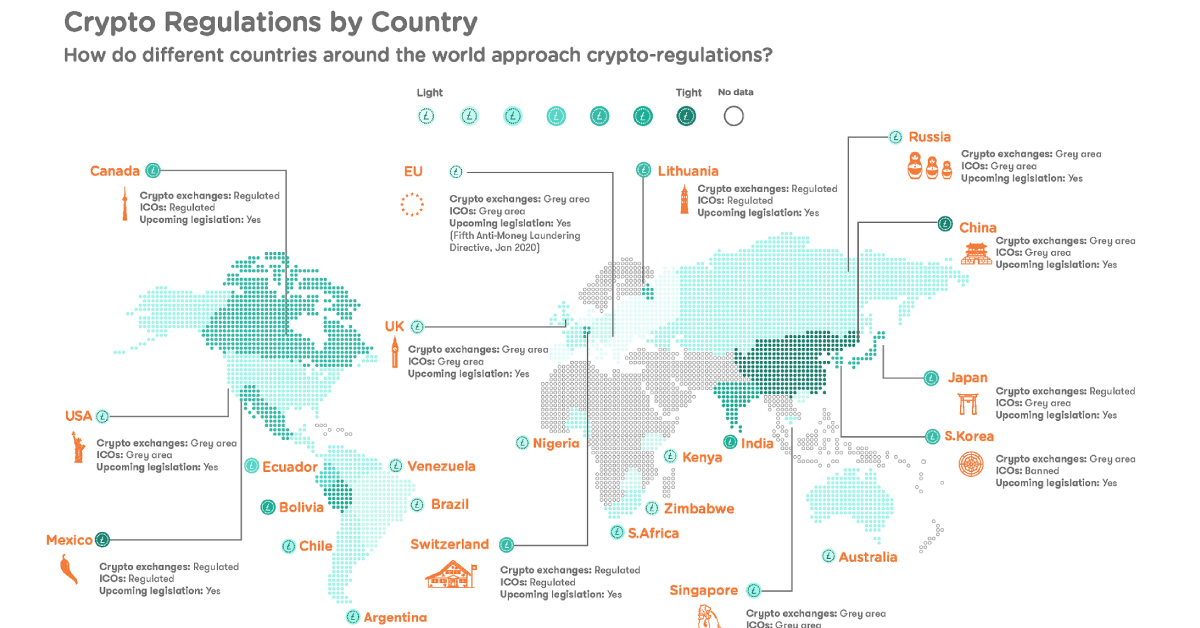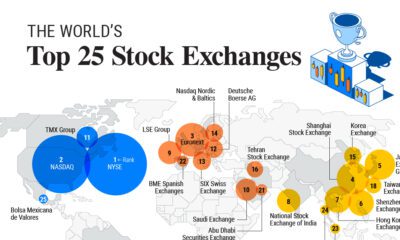Technology
Mapped: Cryptocurrency Regulations Around the World

Mapped: Cryptocurrency Regulations Around the World
Following the unprecedented cryptocurrency boom in 2017, investors and governments alike could no longer ignore the growth of decentralized finance.
The world has become increasingly fascinated with cryptocurrencies and the ways they are enabling greater access, such as being able to send funds to remote places or securing capital for small businesses.
To aid this, cryptocurrency regulations are being slowly introduced into global financial markets. Regulations help to monitor these emerging digital currencies, and to allow for clearer guidelines and a measure of security.
The Regulatory Landscape
Today’s graphic from ComplyAdvantage maps out major regulatory cryptocurrency and exchange landscapes around the world, showing how sentiments towards digital currencies are evolving.
To do this, ComplyAdvantage measured cryptocurrency regulatory environments using their own Light-to-Tight scale, based on the following criteria:
- Cryptocurrencies and exchanges status? (Ban = 3 points, Regulated = 2 points, Grey Area = 1 point)
- Cryptocurrency considered legal tender? (Yes = 1 point, No = 0 points)
- Planned legislation to increase crypto regulation? (Yes = 1 point, No = 0 points)
Which jurisdictions have the strictest and most relaxed regulations for cryptocurrencies?
Regulations by Region
Global attitudes towards the rise of cryptocurrencies have shifted greatly over the past few years. While the term cryptocurrency is a bit of a misnomer, some countries do consider digital currencies legal tender, with many viewing cryptocurrencies as commodities.
Below is a table of the major countries that are pursuing cryptocurrency regulations:
| Country | Cryptocurrencies | Exchanges | Initial Coin Offerings (ICOs) |
|---|---|---|---|
| Australia | Legal; treated as property | Legal, must register with AUSTRAC | Regulated |
| Switzerland | Legal; generally accepted as payment | Legal, regulated by SFTA | Regulated |
| Malta | Not legal tender | Legal, regulated under the VFA Act | Regulated |
| Estonia | Not legal tender | Legal, must register with the Financial Intelligence Unit | Regulated |
| Gibraltar | Not legal tender | Legal, must register with the GFSC | Regulated |
| Luxembourg | Not legal tender | Legal, must register with the CSSF | Regulated |
| Canada | Not legal tender; some retailers accept as payment | Legal, regulation varies by province; final federal regulations expected late 2019 | Regulated |
| Mexico | Legal, accepted as payment in some contexts | Grey area; first crypto exchange in opened mid 2019 | Regulated |
| Lithuania | Not legal tender | Legal, must register with the Lithuanian Finance Ministry | Grey area |
| United States | Not legal tender; some retailers accept as payment | Legal, regulation varies by state; SEC expected to publish updated crypto regulations late 2019 | Grey area |
| UK | Not legal tender; considered assets | Legal, registration requirements with FCA | Grey area |
| Russia | Not legal tender | Grey area; regulations to be determined by the end of 2019 | Grey area |
| Japan | Legal; treated as property | Legal, must register with the Financial Services Agency | Grey area |
| Nigeria | Legal | Grey area; regulations upcoming from Central Bank of Nigeria | Grey area |
| Singapore | Not legal tender | Legal, no registration required | Grey area |
| South Korea | Not legal tender | Legal and regulated, must register with FSS | Banned |
| India | Not legal tender; digital rupee may be in the works | Effectively illegal, but global and federal regulations being considered | Banned |
| China | Bitcoin considered property; all other cryptocurrencies banned | Illegal, but a global regulatory framework being considered | Banned |
Sources: ComplyAdvantage, HedgeTrade, CoinDesk
Asia
Japan has one of the most progressive regulatory climates for cryptocurrencies, widely considering bitcoin as legal tender and passing a law in mid-2017 recognizing cryptocurrencies as legal property. In late 2018, Japan also approved self-regulation for the crypto industry.
By contrast, China currently has one of the most restrictive environments in the world for cryptocurrency. China banned bitcoin transactions in 2013, as well as ICOs and crypto exchanges in 2017─though many have found workarounds through sites not yet firewalled.
Europe
Cryptocurrency and exchange regulations in the EU are determined by individual member states, and are considered legal across the bloc.
Digital currency offers great promise, through its ability to reach people and businesses in remote and marginalized regions.
—Christine Lagarde, Managing Director of IMF
Perhaps unsurprisingly, Switzerland has one of the most open climates for cryptocurrencies and exchanges in Europe. In 2016, the city of Zug, known as “Crypto Valley”, started accepting bitcoin as payment for city fees. Swiss Economics Minister Johann Schneider-Ammann announced his goal in 2018 to make Switzerland the world’s first “crypto-nation”.
North America
Both Canada and the U.S. take a similar approach to cryptocurrency legislation at the federal level, as both countries view cryptocurrencies as securities. However, provincial and state regulations differ widely in their taxation requirements of profits from crypto investments.
Latin America
Regulations throughout Latin and South America run the full legislative spectrum.
- Bolivia: unilateral ban on cryptocurrencies and exchanges
- Ecuador: the first country to launch its own token; ban on all cryptocurrencies aside from its government-issued SDE token (Sistema de Dinero Electrónico = electronic money system)
- Mexico, Argentina, Brazil, Chile: cryptocurrencies widely accepted as payment
- Venezuela: cryptocurrencies widely accepted; this makes sense, considering the economic crisis and subsequent freefall of the bolívar
The Importance of Cryptocurrency Regulations
Cryptocurrency’s journey is the story of a technology rapidly outpacing the laws that govern it.
Governments around the world are keenly aware of this problem. Members of the G20 published a request in June 2019 for a global regulatory framework for cryptocurrencies to be implemented to better manage the benefits and challenges that cryptocurrencies bring.
Regulation for both cryptocurrencies and crypto exchanges is essential for the future of digital finance─bringing legitimacy to the digital financial market, and making it more attractive for new businesses, established banks, and investors worldwide to more easily conduct business within this emerging ecosystem.
Brands
How Tech Logos Have Evolved Over Time
From complete overhauls to more subtle tweaks, these tech logos have had quite a journey. Featuring: Google, Apple, and more.

How Tech Logos Have Evolved Over Time
This was originally posted on our Voronoi app. Download the app for free on iOS or Android and discover incredible data-driven charts from a variety of trusted sources.
One would be hard-pressed to find a company that has never changed its logo. Granted, some brands—like Rolex, IBM, and Coca-Cola—tend to just have more minimalistic updates. But other companies undergo an entire identity change, thus necessitating a full overhaul.
In this graphic, we visualized the evolution of prominent tech companies’ logos over time. All of these brands ranked highly in a Q1 2024 YouGov study of America’s most famous tech brands. The logo changes are sourced from 1000logos.net.
How Many Times Has Google Changed Its Logo?
Google and Facebook share a 98% fame rating according to YouGov. But while Facebook’s rise was captured in The Social Network (2010), Google’s history tends to be a little less lionized in popular culture.
For example, Google was initially called “Backrub” because it analyzed “back links” to understand how important a website was. Since its founding, Google has undergone eight logo changes, finally settling on its current one in 2015.
| Company | Number of Logo Changes |
|---|---|
| 8 | |
| HP | 8 |
| Amazon | 6 |
| Microsoft | 6 |
| Samsung | 6 |
| Apple | 5* |
Note: *Includes color changes. Source: 1000Logos.net
Another fun origin story is Microsoft, which started off as Traf-O-Data, a traffic counter reading company that generated reports for traffic engineers. By 1975, the company was renamed. But it wasn’t until 2012 that Microsoft put the iconic Windows logo—still the most popular desktop operating system—alongside its name.
And then there’s Samsung, which started as a grocery trading store in 1938. Its pivot to electronics started in the 1970s with black and white television sets. For 55 years, the company kept some form of stars from its first logo, until 1993, when the iconic encircled blue Samsung logo debuted.
Finally, Apple’s first logo in 1976 featured Isaac Newton reading under a tree—moments before an apple fell on his head. Two years later, the iconic bitten apple logo would be designed at Steve Jobs’ behest, and it would take another two decades for it to go monochrome.
-

 Travel1 week ago
Travel1 week agoAirline Incidents: How Do Boeing and Airbus Compare?
-

 Markets2 weeks ago
Markets2 weeks agoVisualizing America’s Shortage of Affordable Homes
-

 Green2 weeks ago
Green2 weeks agoRanked: Top Countries by Total Forest Loss Since 2001
-

 Money2 weeks ago
Money2 weeks agoWhere Does One U.S. Tax Dollar Go?
-

 Misc2 weeks ago
Misc2 weeks agoAlmost Every EV Stock is Down After Q1 2024
-

 AI2 weeks ago
AI2 weeks agoThe Stock Performance of U.S. Chipmakers So Far in 2024
-

 Markets2 weeks ago
Markets2 weeks agoCharted: Big Four Market Share by S&P 500 Audits
-

 Real Estate2 weeks ago
Real Estate2 weeks agoRanked: The Most Valuable Housing Markets in America















